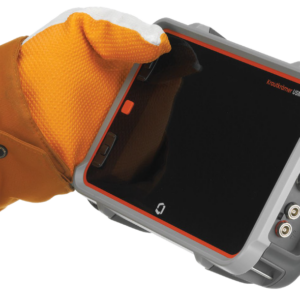Description
It is easy to measure the ferrite content accurately when using the Feritscope®. Upon probe placement on the surface of the specimen, the reading is displayed automatically and stored in the instrument. The probe can also be placed onto hard-to-reach areas. For such applications, the instrument features an “external start” function to trigger the measurements with the push of a button. This is ideal for measurements in pipes, boreholes, or grooves.
Finding weld seams in polished surfaces is made easy through the “continuous display” instrument function. When scanning the surface with the probe with this function enabled, the continuous readings are displayed only. A change in the ferrite content reading indicates that the weld seam has been found. For easy ferrite content measurements along a weld seam, the instrument offers the “continuous measurement capture” function. When scanning the weld seam with the probe positioned, the continuous readings are captured and stored. This provides a ferrite content profile along the weld seam.
Measurement influencing factors do not significantly affect the instrument. Ferrite content measurements can be carried out regardless of the substrate material properties starting at a plating thickness of 3 mm.
Corrective calibrations with customer-specific calibration standards or correction factors (included) can be used to take influences of the specimen shape (strong curvature), plating and substrate thicknesses into account. The calibration is always stored measurement-application specific in the respective application memory.
The instrument is designed to be robust and is well suited to on-site measurement as well as use in QA rooms and metallurgical laboratories. There is a large display and user-friendly menu system with USB and Bluetooth options. A large memory with sophisticated data handling and statistical evaluation of measurements is provided.
Explore Further: Test Ferrite content in austenitic and duplex steels to ensure high corrosion and acid resistance at high temperatures.
To obtain comparable measurement results, the instruments must be adjusted or calibrated using standards that can be traced to internationally recognized secondary standards. For this purpose, the IIW (International Institute of Welding, UK) developed secondary standards that have been determined by the TWI (The Welding Institute, UK) according to the method described in DIN EN ISO 8249 and ANSI/AWS A4.2.
Helmut Fischer offers certified calibration standard sets that are traceable to the TWI secondary standards for corrective and master calibrations. The standards of the FISCHER calibration standard sets list in addition to the ferrite numbers FN also the % Fe values. Influences including the shape of the part to be measured (strong curvature, thickness of the ferrite-containing coating, etc.) can be considered through corrective calibrations with customer-specific calibration standards or through correction factors (included). The normalization and corrective calibration are stored application-specific in the respective application memory of the instrument.
The Feritscope® FMP30 measures according to the magnetic induction method. A magnetic field generated by a coil begins to interact with the magnetic portions of the specimen. The changes in the magnetic field induce a voltage proportional to the ferrite content in a second coil. This voltage is then evaluated. All magnetic portions in the otherwise non-magnetic structure are measured, i.e., in addition to delta ferrite and other ferritic portions also strain-induced martensite, for example.
A specific advantage of the magnetic induction method for measuring the ferrite content is that a sigma phase, i.e., a Fe-Cr precipitation, which has formed due to excess ferrite content and unfavorable cooling conditions, for example, is recognized correctly as a non-ferritic structural component. In comparison, erroneous interpretation of ferrite content is likely in a metallographic section where a sigma phase is not easily distinguished from a ferritic structure.
The instrument can be outfitted with a variety of probes in special shapes such as axial, angled, or for measuring inside center holes.



 FMP30
FMP30
